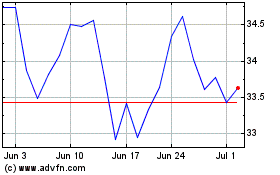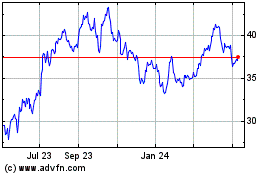Drilling Contractor Weatherford Cancels Fund-Raising Effort
September 22 2015 - 6:50PM
Dow Jones News
One of the biggest drilling contractors in the world abandoned
its efforts to raise about $1 billion in cash after investors
hammered its stock, in sign that Wall Street's love affair with
energy finance is cooling along with hopes that oil prices will
rise anytime soon.
Weatherford International Ltd. said Monday morning that it
planned to sell a combination of shares and convertible bonds for
unspecified potential acquisitions. The company's shares quickly
fell about 17%, to $8.41, prompting the company to cancel the
offerings just 14 hours after unveiling the plan.
"While investor interest was strong for this offering, we are
unwilling to sell securities at prices that do not reflect the
value we have created at Weatherford," the company said.
A Weatherford spokeswoman declined to comment beyond the
company's press release.
The about-face helped Weatherford's stock regain some of
Monday's losses; in 4 p.m. trading Tuesday on the New York Stock
Exchange, the shares were up more than 10% at $9.31.
The episode soured some investors and analysts, who said that
Weatherford executives had promised to focus on reducing debt at
the beleaguered company, which has struggled in recent years with
undigested acquisitions and accounting problems. Houston-based
energy investment bank Tudor, Pickering, Holt & Co. said in a
note to clients that there is "no point to sugarcoating [the] blow
to management credibility."
The stock market's reaction contrasts with investor sentiment
earlier this year, when energy producers were able to sell record
amounts of new stock and bonds to shore up their balance sheets,
replace bank financing and fund acquisitions.
North American energy producers have sold about $17 billion of
new stock this year, according to a Wall Street Journal analysis of
Dealogic data. The bulk of those offerings came during the first
part of the year, when many investors expected oil prices to bounce
back toward the triple-digit levels of a year ago. Instead, after a
brief uptick, U.S. oil prices have ducked back below $50 a
barrel.
That's left many investors nursing big losses. Whiting Petroleum
Corp., a North Dakota oil producer, put itself on the block early
in the year before deciding instead to raise cash selling stock and
bonds. Whiting sold $1.05 billion of new shares in late March at
$30 apiece; now they are trading for less than $18, a decline of
more than 40%.
A few energy companies have succeeded in selling stock recently;
Memorial Resources Development Corp., an oil producer, said Tuesday
that it sold about $243 million of new shares this week to fund an
acquisition of Louisiana drilling land, boosting the size of the
offering at the last minute amid strong demand.
Oilfield-service companies like Weatherford, however, have
raised less than $500 million this year, according to Dealogic.
Such companies often suffer the most during energy-price downturns
because the oil and gas producers they work for cut back on
drilling and squeeze contractors on pricing.
Weatherford been losing ground to its larger rivals. The
company, which is based in Baar, Switzerland, and has its
operational headquarters in Houston, has long been a distant fourth
to oilfield-services giants Schlumberger Ltd., Halliburton Co. and
Baker Hughes Inc.
Halliburton said in November that it planned to buy Baker Hughes
for about $35 billion, and Schlumberger last month said it would
buy Cameron International Corp., a maker of drilling equipment, for
$12.7 billion.
Having more cash on hand would have made Weatherford a stronger
player if it bid for businesses Halliburton and Baker Hughes plan
to shed in order to pass antitrust scrutiny. Some of those
businesses make strategic sense for Weatherford, but investors
prefer that the company focus on cleaning up its own house, said
William Herbert, co-head of research at Houston-based energy
investment bank Simmons & Co. International.
"They don't necessarily want Weatherford to be adventurous with
regards to taking advantage of this downturn," Mr. Herbert said.
"They don't want this management team to take big bets with the
balance sheet."
Under Chairman and Chief Executive Bernard Duroc-Danner,
Weatherford grew into the world's fourth largest oilfield-services
company by making more than 100 acquisitions over 20 years. But it
began to show signs it was overextended, announcing in 2011 that an
internal review uncovered tax-accounting errors that prompted
multiple restatements of earnings in recent years.
The company agreed in 2013 to pay nearly $253 million to resolve
yearslong U.S. government investigations into foreign bribery and
trade-sanction violations—problems that the Securities and Exchange
Commission attributed to "the nonexistence of internal
controls."
More recently Weatherford said it would slim down by selling off
business units outside its core and laying off staff. Last year it
brought in $1.7 billion by selling "noncore" businesses. In July,
Mr. Duroc-Danner told investors, "I think our time is better used
focusing on what we have than on sort of daydreaming about what we
could be adding or not."
Subscribe to WSJ: http://online.wsj.com?mod=djnwires
(END) Dow Jones Newswires
September 22, 2015 18:35 ET (22:35 GMT)
Copyright (c) 2015 Dow Jones & Company, Inc.
Halliburton (NYSE:HAL)
Historical Stock Chart
From Mar 2024 to Apr 2024

Halliburton (NYSE:HAL)
Historical Stock Chart
From Apr 2023 to Apr 2024
